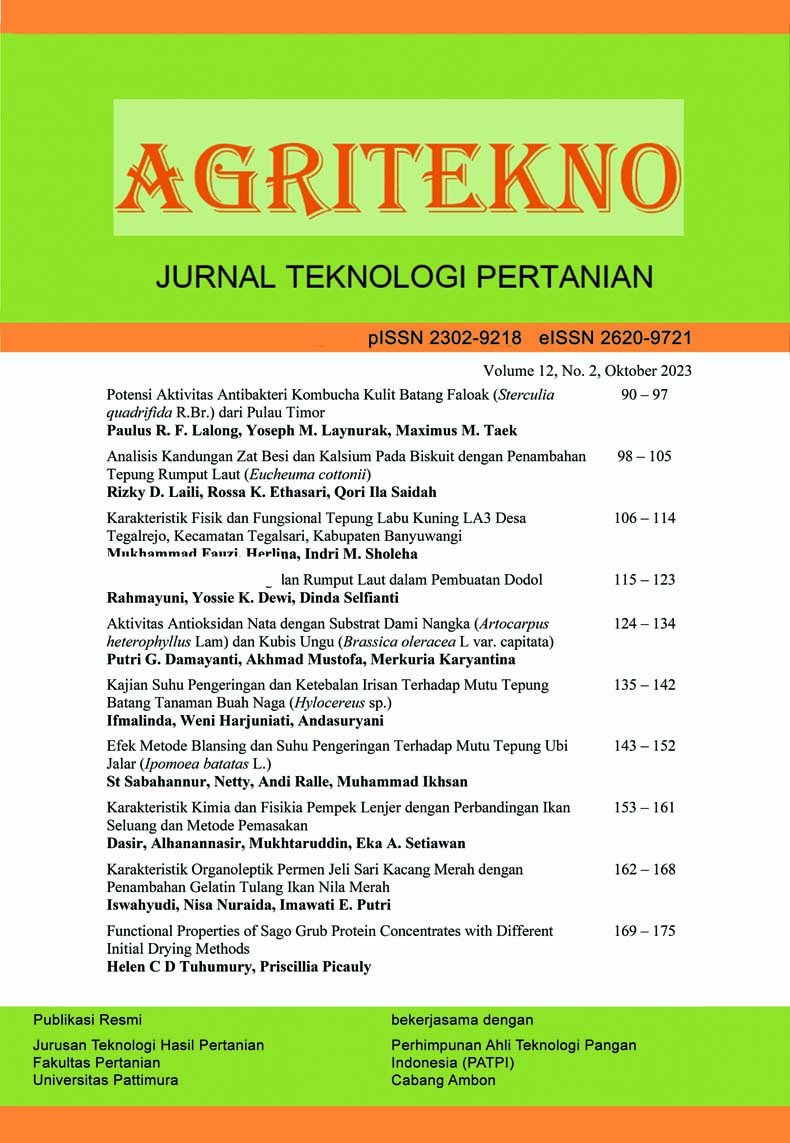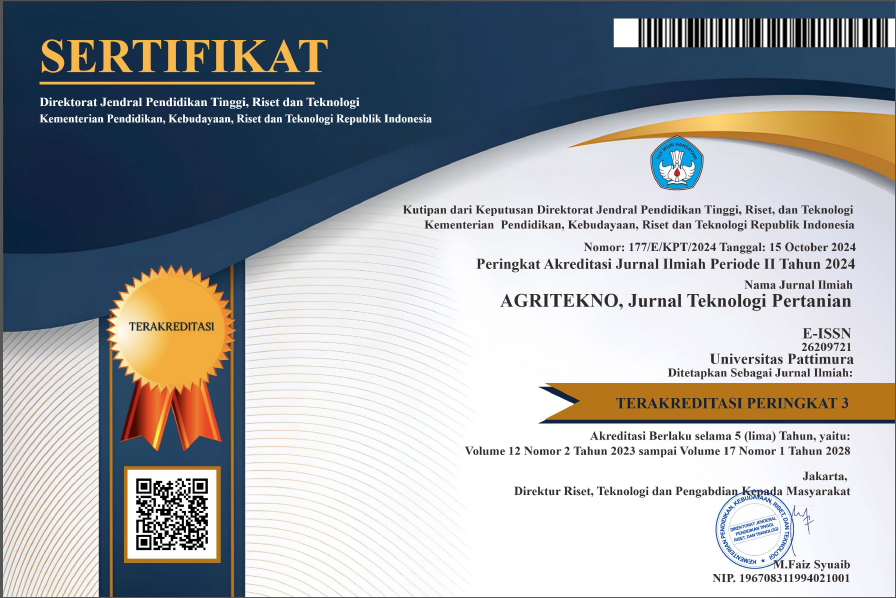Potensi Aktivitas Antibakteri Kombucha Kulit Batang Faloak (Sterculia quadrifida R.Br.) dari Pulau Timor
Antibacterial Activity Potential of Kombucha Made with Faloak (Sterculia quadrifida R.Br.) Stem Bark from Timor Island
Abstract
Exploration of the potential of alternative ingredients to replace black tea or green tea in making kombucha has begun to be widely carried out. On Timor Island, faloak stem bark is processed into a traditional drink by some locals. For this reason, the use of faloak stem bark as a basic ingredient for kombucha needs to be studied, especially in exploring its antibacterial potential, which is analyzed based on the concentration of sugar used. This study aims to determine the chemical characteristics and antibacterial activity of faloak stem bark kombucha with various concentrations of sugar. The methods involved making faloak stem bark kombucha with varying sugar concentrations of 6, 8, 10, and 12% (w/v), and testing chemical characteristics in the form of pH, total acid, total sugar, and total phenol tests. Meanwhile, the antibacterial activity testing used a good diffusion method against Escherichia coli ATCC 25922 bacteria. After 14 days of fermentation, faloak stem bark kombucha with a 12% sugar concentration showed the best chemical characteristics, with pH, total acid, total sugar, and total phenol values of 2.91, 1.19%, 7.33%, and 420.15 mg GAE/L, respectively. Furthermore, antibacterial activity also showed the highest inhibition (13.02 mm) at a sugar concentration of 12%. Thus, faloak bark kombucha made with a sugar concentration of 12% has the potential to be antibacterial.
Downloads
References
Alaei, Z., Doudi, M., & Setorki, M. (2020). The protective role of Kombucha extract on the normal intestinal microflora, high-cholesterol diet caused hypercholesterolemia, and histological structures changes in New Zealand white rabbits Effects of Kombucha on hypercholesterolemia and histological structures in rabbits. Original Research Article AJP, 10(6), 601-614.
Al-Mohammadi, A. R., Ismaiel, A. A., Ibrahim, R. A., Moustafa, A. H., Zeid, A. A., & Enan, G. (2021). Chemical constitution and antimicrobial activity of kombucha fermented beverage. Molecules, 26(16), 1-18. https://doi.org/10.3390/molecules26165026
Aloulou, A., Hamden, K., Elloumi, D., Ali, M. B., Hargafi, K., Jaouadi, B., Ayadi, F., Elfeki, A., & Ammar, E. (2012). Hypoglycemic and antilipidemic properties of kombucha tea in alloxan-induced diabetic rats. BMC Complementary and Alternative Medicine, 12(1-9). https://doi.org/10.1186/1472-6882-12-63
[AOAC]. (1995). Association of Official Analytical Chemist 16th ed. Official Methods of Analysis, Washinghton D.C.
Bhattacharya, S., Gachhui, R., & Sil, P. C. (2013). Effect of Kombucha, a fermented black tea in attenuating oxidative stress mediated tissue damage in alloxan induced diabetic rats. Food and Chemical Toxicology, 60, 328–340. https://doi.org/10.1016/j.fct.2013.07.051
Chakravorty, S., Bhattacharya, S., Chatzinotas, A., Chakraborty, W., Bhattacharya, D., & Gachhui, R. (2016). Kombucha tea fermentation: Microbial and biochemical dynamics. International Journal of Food Microbiology, 220, 63–72. https://doi.org/10.1016/j.ijfoodmicro.2015.12.015
Coton, M., Pawtowski, A., Taminiau, B., Burgaud, G., Deniel, F., Coulloumme-Labarthe, L., Fall, A., Daube, G., & Coton, E. (2017). Unraveling microbial ecology of industrial-scale Kombucha fermentations by metabarcoding and culture-based methods. FEMS Microbiology Ecology, 93(5), 1-16. https://doi.org/10.1093/femsec/fix048
Davis, W. W., & Stout, T. R. (1971). Disc Plate Method of Microbiological Antibiotic Assay I. Factors influencing variability and error. Applied Microbiology, 22(4), 659-665. https://doi.org/10.1128/am.22.4.659-665.1971
Doudi, M., Hooshmandi, Z., Saedi, S., & Setorki, M. (2020). Effects of kombucha tea on side effects of high cholesterol diet in rabbits. Pharmaceutical and Biomedical Research, 6(2), 123-132. https://doi.org/10.18502/pbr.v6i2.3804
Emiljanowicz, K. E., & Malinowska-Pańczyk, E. (2020). Kombucha from alternative raw materials–The review. Critical Reviews in Food Science and Nutrition, 60(19), 3185–3194. https://doi.org/10.1080/10408398.2019.1679714
Islam, M. K., Khan, M. Z. H., Sarkar, M. A. R., Absar, N., & Sarkar, S. K. (2013). Changes in acidity, TSS, and sugar content at different storage periods of the postharvest mango (Mangifera indica L.) influenced by Bavistin DF. International Journal of Food Science, 2013. https://doi.org/10.1155/2013/939385
Ivanišová, E., Tokár, M., Mocko, K., Bojňanská, T., Mareček, J., & Mendelová, A. (2013). Antioxidant activity of selected plant products. Journal of Microbiology, 2(1), 1692-1703.
Jayabalan, R., Malbaša, R. v., Lončar, E. S., Vitas, J. S., & Sathishkumar, M. (2014). A review on kombucha tea-microbiology, composition, fermentation, beneficial effects, toxicity, and tea fungus. Comprehensive Reviews in Food Science and Food Safety, 13(4), 538–550. https://doi.org/10.1111/1541-4337.12073
Jayabalan, R., & Waisundara, V. Y. (2019). Kombucha as a Functional Beverage. In Functional and Medicinal Beverages: Volume 11: The Science of Beverages, (413–446). Academic Press. https://doi.org/10.1016/B978-0-12-816397-9.00012-1
Kaewkod, T., Bovonsombut, S., & Tragoolpua, Y. (2019). Efficacy of kombucha obtained from green, oolong and black teas on inhibition of pathogenic bacteria, antioxidation, and toxicity on colorectal cancer cell line. Microorganisms, 7(12), 1-18. https://doi.org/10.3390/microorganisms7120700
Laavanya, D., Shirkole, S., & Balasubramanian, P. (2021). Current challenges, applications and future perspectives of SCOBY cellulose of Kombucha fermentation. Journal of Cleaner Production 295, 1-20. https://doi.org/10.1016/j.jclepro.2021.126454
Lalong, P. R. F., Zubaidah, E., & Martati, E. (2022a). In vivo evaluation of faloak (Sterculia quadrifida R.Br) stem bark kombucha as hyperglycemia and therapeutic agent. E3S Web of Conferences, 344, 02002. https://doi.org/10.1051/e3sconf/202234402002
Lalong, P. R. F., Zubaidah, E., & Martati, E. (2022b). Karakteristik kimia dan potensi antioksidan dari kombucha berbahan kulit batang faloak (Sterculia quadrifida R.Br). Teknologi Pangan : Media Informasi Dan Komunikasi Ilmiah Teknologi Pertanian, 13(1), 134–143. https://doi.org/10.35891/tp.v13i1.2873
Ma, Y., Ding, S., Fei, Y., Liu, G., Jang, H., & Fang, J. (2019). Antimicrobial activity of anthocyanins and catechins against foodborne pathogens Escherichia coli and Salmonella. Food Control, 106, 106712. https://doi.org/10.1016/j.foodcont.2019.106712
Mo, H., Zhu, Y., & Chen, Z. (2008). Microbial fermented tea - a potential source of natural food preservatives. Trends in Food Science and Technology, 19(3), 124–130. https://doi.org/10.1016/j.tifs.2007.10.001
Napitupulu, M. O. C., Setyohadi, & Lubis, L. M. (2015). The effect of sugar concentration and the fermentation time of kombucha coffee. Jurnal Rekayasa Pangan dan Pertanian, 3(3), 316-322.
Rollando. (2015). Penelusuran potensi aktivitas antibakteri dan antioksidan fraksi kulit pohon faloak (Sterculia quadrifida R.Br). Journal of Pharmacy, 4(1), 1-8.
Siswadi, D. H. S., Grace, S. S., & Heny, R. (2013). The potency of faloak’s (Sterculia quadrifida R. Br 1844) active compounds as natural remedy. Kupang Forest Research Institute, January 2020. https://doi.org/10.5281/zenodo.3353788
Tan, W. C., Muhialdin, B. J., & Hussin, A. S. M. (2020). Influence of storage conditions on the quality, metabolites, and biological activity of soursop (Annona muricata L.) kombucha. Frontiers in Microbiology, 11, 603481. https://doi.org/10.3389/fmicb.2020.603481
Valiyan, F., Koohsari, H., & Fadavi, A. (2021). Use of response surface methodology to investigate the effect of several fermentation conditions on the antibacterial activity of several kombucha beverages. Journal of Food Science and Technology, 58(5), 1877–1891. https://doi.org/10.1007/s13197-020-04699-6
Villarreal-Soto, S. A., Beaufort, S., Bouajila, J., Souchard, J. P., & Taillandier, P. (2018). Understanding kombucha tea fermentation: A Review. Journal of Food Science, 83(3), 580–588. https://doi.org/10.1111/1750-3841.14068
Vitas, J. S., Cvetanović, A. D., Mašković, P. Z., Švarc-Gajić, J. v., & Malbaša, R. v. (2018). Chemical composition and biological activity of novel types of kombucha beverages with yarrow. Journal of Functional Foods, 44, 95–102. https://doi.org/10.1016/j.jff.2018.02.019
Winanta, A., Hertiani, T., Purwantiningsih, & Siswadi. (2019). In vivo Immunomodulatory Activity of Faloak Bark Extract (Sterculia quadrifida R.Br). Pakistan Journal of Biological Sciences, 22(12), 590–596. https://doi.org/10.3923/pjbs.2019.590.596
Zou, C., Li, R. Y., Chen, J. X., Wang, F., Gao, Y., Fu, Y. Q., Xu, Y. Q., & Yin, J. F. (2021). Zijuan tea- based kombucha: Physicochemical, sensorial, and antioxidant profile. Food Chemistry, 363. https://doi.org/10.1016/j.foodchem.2021.130322
Zubaidah, E., Dewantari, F. J., Novitasari, F. R., Srianta, I., & Blanc, P. J. (2018). Potential of snake fruit (Salacca zalacca (Gaerth.) Voss) for the development of a beverage through fermentation with the Kombucha consortium. Biocatalysis and Agricultural Biotechnology, 13, 198–203. https://doi.org/10.1016/j.bcab.2017.12.012
Copyright (c) 2023 The Author(s)

This work is licensed under a Creative Commons Attribution-ShareAlike 4.0 International License.
Authors who publish with this journal agree to the following terms:
- Authors retain copyright and grant the journal the right of first publication with the work simultaneously licensed under a Creative Commons Attribution License that allows others to share the work with an acknowledgement of the work's authorship and initial publication in this journal.
- Authors are able to enter into separate, additional contractual arrangements for the non-exclusive distribution of the journal's published version of the work (e.g., post it to an institutional repository or publish it in a book), with an acknowledgement of its initial publication in this journal.
- Authors are permitted and encouraged to post their work online (e.g., in institutional repositories or on their website) prior to and during the submission process, as it can lead to productive exchanges, as well as earlier and greater citation of published work (See The Effect of Open Access).









